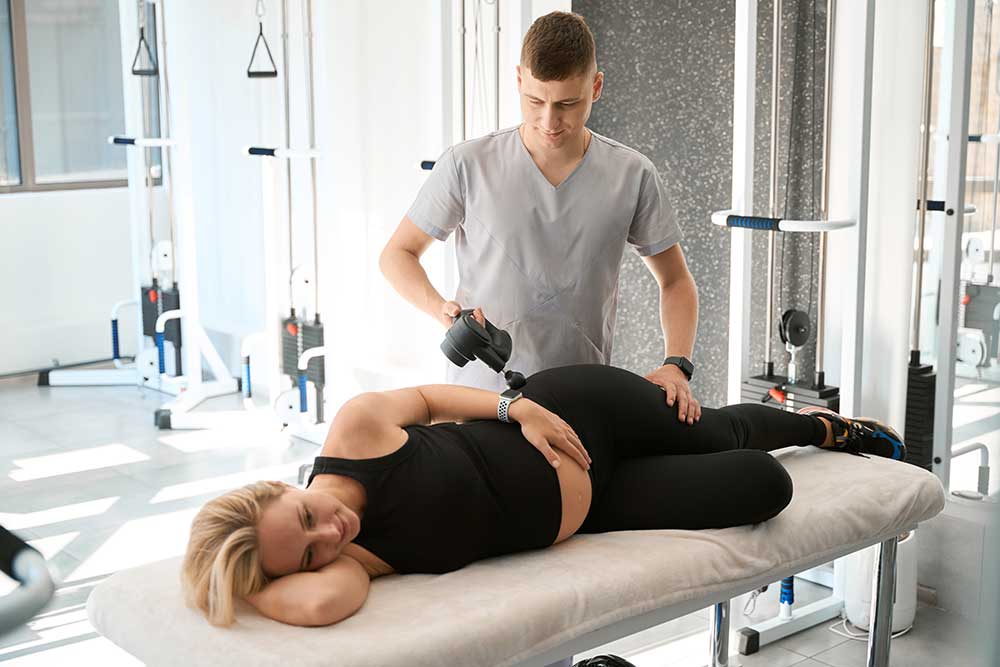Why Do Chiropractic Techniques Enhance Posture Improvement?
Navigating the complex relationship between chiropractic care and posture enhancement is a journey many embark on as they seek solutions to persistent back discomfort and the desire for a healthier, more aligned body. You might be exploring how targeted spinal adjustments and a holistic approach can bring much-needed relief and a firmer stance in both a literal and metaphorical sense.
Understanding the intricacies of spinal health is not just for those who experience pain or stiffness; it is a pursuit for anyone yearning for a deeper sense of bodily harmony. With a wealth of experience in addressing the subtle nuances of musculoskeletal health, the insights offered here are grounded in a comprehensive approach to care.
For those navigating the often-overwhelming landscape of wellness options, rest assured that this exploration is tailored to demystify the science behind posture correction and empower you with knowledge.
As we delve into the mechanisms that underlie the effectiveness of chiropractic techniques, you are invited to continue on this path to discover how these practices can be a cornerstone in achieving the posture you strive for.
Key Points
- Chiropractic adjustments and exercises can help to restore spinal function and improve posture.
- Chiropractic care takes a holistic approach to address posture issues and promotes self-healing.
- Spinal adjustments correct misalignments, reduce inflammation, and relieve pain, targeting underlying causes of poor posture.
- Cervical curve correction techniques can enhance neck curvature, alleviate neck pain and headaches, and improve overall flexibility.
Understanding Chiropractic Techniques
To fully appreciate the effectiveness of chiropractic care in posture improvement, it is essential to understand the specific chiropractic techniques employed in correcting spinal misalignments and devising personalised treatment plans. Chiropractic adjustments, the core of chiropractic care, are precise manipulations applied to the vertebrae that are not performing correctly. This technique aims to restore normal spinal function, improve posture and reduce the patient’s pain.
Understanding chiropractic techniques goes beyond manual adjustments. Chiropractors often incorporate stretching and rehabilitation exercises into treatment plans. These exercises strengthen the back muscles and improve flexibility, both critical factors in maintaining proper posture.
Chiropractic care’s holistic approach considers the overall health and well-being of the patient when addressing posture issues. This comprehensive strategy ensures that postural treatment is not just about aligning the spine but also about promoting the body’s overall ability to self-heal and adapt to physical stresses. It is a non-invasive method that not only corrects posture problems but also contributes to the body’s general health and functionality.
Role of Spinal Adjustments
The role of spinal adjustments, also known as spinal manipulations, is to correct misalignments in the spine. These misalignments, also called subluxations, can occur due to various factors such as poor posture, injuries, or repetitive stress.
Spinal adjustments are performed by chiropractors or other healthcare professionals who specialize in this technique. The goal of these adjustments is to restore proper movement and alignment to the spine, which can help relieve pain, improve function, and promote overall wellness.
During a spinal adjustment, the healthcare professional applies controlled force to specific areas of the spine using their hands or specialized instruments. This force helps to realign the vertebrae, reduce inflammation, and alleviate pressure on the
Building upon the understanding of chiropractic techniques, it becomes clear that spinal adjustments play a crucial role in the correction of posture-related issues. The role of spinal adjustments in chiropractic treatment cannot be overstated, as they directly target the underlying causes of poor posture, primarily through the correction of spinal alignment.
Spinal adjustments provide three significant benefits:
- Correction of Spinal Misalignments: Chiropractic techniques aim to correct misalignments in the spine, which is key to achieving optimal spinal alignment and improving posture.
- Reduction of Muscle Tension: By including muscle relaxation techniques in their treatment plan, chiropractors alleviate muscle tension and tightness that often contribute to postural imbalances.
- Personalised Treatment Plans: Chiropractors develop individualised treatment plans tailored to each patient’s specific needs, offering a holistic, non-invasive approach to posture correction.
Methods for Cervical Curve Correction
The cervical curve, or neck curvature, is a crucial aspect of overall postural alignment, and its correction can bring about numerous benefits. Chiropractic techniques offer a non-invasive approach to correcting these curvatures, enhancing both comfort and functionality.
In the following discussion, we will explore these techniques, the benefits of cervical curve correction, and deepen our understanding of this essential chiropractic practice.
Understanding Cervical Curve Correction
In the realm of chiropractic care, cervical curve correction is a vital technique used to enhance the natural curvature of the neck and upper spine. Understanding cervical curve correction is essential for maintaining good posture and overall spinal health.
Chiropractors use specific adjustments and exercises to restore the normal curvature of the neck, known as the cervical lordosis. This treatment is designed to realign the neck vertebrae, reducing strain and improving posture.
Regular exercises and stretches are recommended to strengthen neck muscles, which support the corrected cervical curve and maintain proper posture.
The ultimate aim of cervical curve correction is not only to improve posture but also to alleviate neck pain and headaches, demonstrating how chiropractic care helps enhance overall well-being.
Advantages of Curve Correction
Employing techniques for cervical curve correction offers many benefits, including the correction of spinal misalignments that contribute to poor posture. Chiropractors help patients achieve a healthy posture through personalised treatment plans and non-invasive methods.
These chiropractic techniques, such as adjustments, stretching, and rehabilitation exercises, improve flexibility and strengthen the back. A healthy posture helps to enhance overall well-being, with chiropractic care taking a holistic approach to patient health.
The Benefits of Chiropractic are not limited to the physical aspects only; it also improves mental clarity and quality of life. Therefore, curve correction is a vital tool in the chiropractic arsenal for posture improvement, offering a safe, effective, and personalised approach to maintaining spinal health and posture.
Chiropractic Techniques Explored
Exploring the various chiropractic techniques, particularly those used for cervical curve correction, reveals a range of non-invasive methods employed by professionals to address postural problems such as hunchback, uneven pelvis, scoliosis, and lower back pain.
- Enquiry and Examination: The chiropractor begins by understanding the patient’s concerns and performing a thorough physical examination. This step is crucial in determining the most suitable approach to improving posture.
- Therapy and Adjustments: Chiropractors employ manipulations and adjustments targeting the spine and other joints. These techniques can help realign the body, thereby improving posture and relieving pain.
- Rehabilitation Exercises: Maintaining proper posture requires consistent effort. Chiropractors often prescribe exercises to strengthen supporting muscles and promote lasting changes.
In essence, the chiropractic techniques explored not only offer immediate relief, but also contribute to long-term posture improvement.
Lumbar Spine Realignment Strategies
Lumbar spine realignment, a cornerstone of chiropractic therapy, offers significant benefits for overall posture improvement.
This discussion will clarify the various techniques used in lumbar realignment, their respective advantages, and challenges.
Furthermore, strategies for maintaining optimal posture after realignment will also be covered, emphasizing the long-term impact of this approach on musculoskeletal health.
Benefits of Lumbar Realignment:
- Improved posture and spinal alignment
- Reduced back and neck pain
- Enhanced flexibility and range of motion
- Increased energy and vitality
- Improved circulation and nerve function
- Better overall health and well-being
In the realm of chiropractic care, one of the most effective strategies for posture improvement is the realignment of the lumbar spine, a key component in maintaining balance and preventing back pain. A skilled chiropractor will work diligently to address postural issues, using various techniques tailored to individual needs.
The benefits of lumbar realignment are numerous:
- It addresses back pain and discomfort, providing immediate and long-term relief.
- It strengthens core muscles. With regular strengthening exercises, the body can maintain optimal alignment, enhancing overall posture.
- It improves balance and coordination, essential elements in everyday living.
Lumbar realignment is therefore a comprehensive approach towards posture improvement, health promotion, and enhanced quality of life.
Realignment Technique Overview
Building on the understanding of the benefits of lumbar realignment, it is crucial to explore the practical techniques chiropractors utilise to achieve optimal spinal alignment and posture improvement.
Chiropractors work with a diverse range of methods which form a comprehensive realignment technique overview. Central to their approach is the correction of spinal misalignments, focusing specifically on the lumbar region. This is achieved through precise chiropractic techniques that aim to restore the body mechanics and promote healthier posture.
An integral part of this process is enhancing joint mobility, which is fundamental for the efficient functioning of the spinal cord. In addition, chiropractors employ muscle relaxation strategies, personalised exercises, stretches, and ergonomic recommendations. These multi-dimensional methodologies contribute significantly to posture improvement.
Post-Realignment Posture Maintenance
Post-realignment posture maintenance, particularly focusing on lumbar spine realignment strategies, is a crucial aspect of chiropractic care that ensures the longevity of treatment results and supports better body mechanics. This process is essential to maintaining good HEALTH CARE habits and fostering substantial posture improvement.
Regular chiropractic adjustments: These correct misalignments and alleviate stiffness in the upper back and pelvis, thereby helping maintain a healthy posture.
Therapy for strained tissues: This, along with personalised exercises and stretching, promotes healing and upkeep of correct posture.
Non-invasive methods: Chiropractic techniques offer non-invasive methods and personalised treatment plans, providing pain relief and aiding in the maintenance of post-realignment posture.
Thus, maintaining a balance between regular chiropractic visits and personal care is essential for effective post-realignment posture maintenance.
Chiropractic Care and Muscle Balance
Addressing the complex interplay between chiropractic care and muscle balance, it becomes evident that chiropractic adjustments can correct spinal misalignments, thereby improving posture and reducing pain. It is essential to understand that poor posture often results from weak muscles and strained tissues, contributing to spinal misalignments.
Chiropractic care’s role in balancing these muscles is crucial. It helps improve not only posture but also promotes overall well-being. The treatment plan developed by chiropractors is personalised to address the unique needs of each individual. It caters to various postural problems, such as hunchback, uneven pelvis, and lower back pain, with a focus on long-term improvement. In addition to enhancing posture, chiropractic therapy benefits for spine health by ensuring that the vertebrae are properly aligned, which can alleviate discomfort and prevent future issues. This alignment supports better nervous system function, contributing to improved overall health. Regular chiropractic sessions can also foster an increased range of motion and flexibility, allowing individuals to engage more fully in their daily activities.
The techniques employed, including muscle relaxation and postural exercises, further promote healing in strained tissues and strengthen weak muscles. These methods enhance posture and enhance overall health, highlighting the holistic approach of chiropractic care.
Preventive measures for posture maintenance
Whilst chiropractic techniques can significantly improve posture by addressing muscle imbalances, a proactive approach involving preventative measures is equally crucial in maintaining this improvement over time.
A commitment to regular chiropractic visits, a personalised exercise plan, and ergonomic adjustments can be pivotal in achieving this goal.
- Regular Chiropractic Visits: Chiropractic care can help identify and correct postural imbalances early on, minimising the risk of developing chronic issues associated with bad posture.
- Personalised exercise plan: Chiropractors can design individualised stretches and exercises that target weak postural muscles. Regular engagement in these exercises can strengthen the muscles responsible for maintaining good posture, directly contributing to overall health.
- Ergonomic adjustments: Implementing ergonomic changes at home and work can offer continual support for maintaining proper posture. These adjustments can help prevent the recurrence of bad posture, promoting long-term health benefits.
These preventive measures for posture maintenance, combined with body awareness education and stress reduction techniques, provide a comprehensive strategy for posture improvement.
Frequently Asked Questions
How Does Chiropractic Help Posture?
Chiropractic techniques help with correcting posture, providing alignment benefits, reduced pain, and improved mobility. This approach deals with the health consequences of bad posture, resulting in long-term effects such as improved well-being and preventive care for future posture problems.
Why do chiropractors manipulate the spine?
Chiropractors adjust the spine to address misalignment issues, enhancing spinal health. These chiropractic methods facilitate pain reduction and mobility improvement, highlighting the crucial role of spinal alignment in overall health and wellbeing.
Why does it feel good to get adjusted by a chiropractor?
Chiropractic adjustments stimulate a sense of relief, release endorphins, and relax muscles, positively affecting the nervous system. This improves emotional well-being, reduces stress, and enhances sleep, contributing to an overall sense of positivity after the adjustment.
Why do chiropractors push on your back?
Chiropractors apply pressure on the back using chiropractic methods to stimulate nerves, reduce pain, and relax muscles. This back manipulation realigns the spine, improving overall body posture, function, and promoting optimal health.









